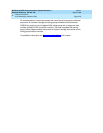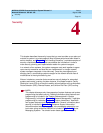
MERLIN LEGEND Communications System Release 6.1
Network Reference
555-661-150
Issue 1
August 1998
Security
Page 4-5Facility Restriction Levels and Remote Access
4
SECURITYlALERT:
!
Networked systems require special attention to security issues. Follow the
rules below when setting up and planning your system for network use.
■
Ensure that barrier codes are required for incoming remote access
calls received on PSTN dial-plan routed facilities and tandem
facilities that route to the local system by dialing the Remote Access
code (889, for example). When you program the default COR, turn
the barrier code requirement on. This setting is ignored for ARS
calls and calls to non-local extensions across the network. However,
it is still applied to DID and PRI dial-plan routed remote access calls
as well as to calls received on a tandem trunk and routed to a
Remote Access code. Because the COR Calling Restriction must be
set to unrestricted for network calling, using barrier codes on these
facilities is essential in order to apply security measures. When a
Remote Access code is included in the non-local dial plan of the
calling system, the caller must enter a barrier code and that barrier
code FRL on the called system is compared to the UDP or ARS
route FRL on the called system. See the
Feature Reference
and
“Remote Access Default Class-of-Restriction Settings” on page 6
for
details.
■
Extension and ARS FRLs should be carefully and stringently
assigned in order to prevent unauthorized trunk-to-trunk transfers to
local PSTN facilities. Table 4–1, page 4-3
explains the operation of
this feature in a networked system.
Facility Restriction Levels and
Remote Access 4
Facility Restrictions Levels (FRLs) are number values from 0 to 6 that are used to
allow or disallow calling. FRLs apply to the following four aspects of systems in a
network:
■ Automatic Route Selection Routes. ARS routes are assigned to
subpatterns that the system selects according to the time of day. Each
route is assigned an FRL. An FRL of 6 is the most restrictive, and an FRL
of 0 is the least restrictive. Factory-set ARS route FRLs are as follows:
— Routes assigned to Default Toll Tables: 3
— Routes assigned to the Default Local Table: 2
— Routes assigned to pools: 3
■ Uniform Dial Plan Routes. UDP routes are associated with patterns that
also specify digit manipulation for directing calls to non-local extensions
over tandem facilities, or directing calls to non-local PSTN facilities. Like
ARS routes, UDP routes are assigned FRLs. The factory setting for UDP
routes is 3.


















